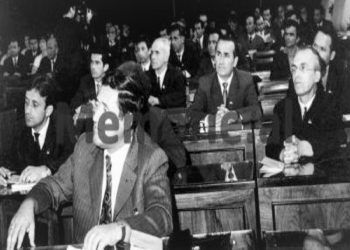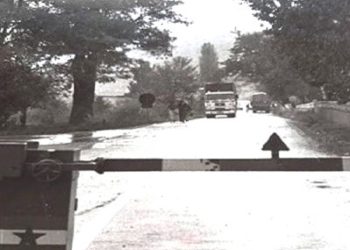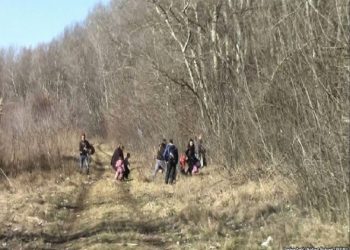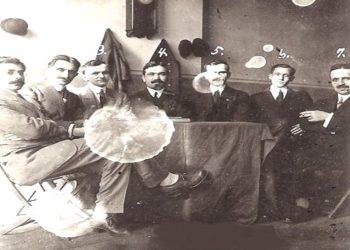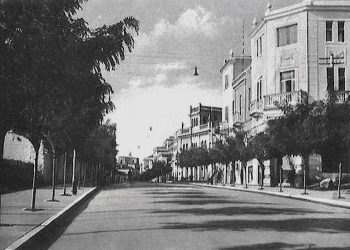Hasan Minga
Hilmi Saqe
Memorie.al The Cham issue was born as a sharp problem in the relations between the two countries, Albania and Greece, which with the Congress of Berlin, in 1878 was justified after the decisions of the Conference of Ambassadors in London 1913, where Chameria and other Albanian countries were unjustly seceded, contenting themselves with their annexations, the neighboring states. Since 1913, Chameria has been occupied by Greece. The capture of the province of Chameria, this barrier for Greece, opened the door to the absurd claims of Greek chauvinism to take over other Albanian territories.
The Cham issue is a national tragedy not only in people, but also in territories. The Cham tragedy is an injustice that needs to be resolved. At the southernmost tip of Albania today lies the Albanian province of Chameria or as it is called today in part by the Greek administration, Thesprotia. It lies in the southernmost part of the ethnic areas of Southern Epirus inhabited by Albanians since antiquity (from the Pelasgian-Illyrian time) until today. It consists of a people of continuity territory. This is evidenced by ancient authors, the great Greek encyclopedia as well as many world scientific authorities. This is confirmed by the living presence, the human factor, Albanians in language, culture and traditions.
The population of Chameria has been homogeneous, 99% Albanian in cities and 100% in villages. Historically, the religious affiliation of the province of Chameria has gone through a long process of change dictated by certain historical circumstances. From paganism to antiquity, to Catholicism in the first centuries of the new era and until the 13th-14th century (the presence of the Catholic faith in Chameria is evidenced by the names of Albanians at that time, especially its princes, such as Pjetër Losha, Gjin Bue Shpata etc., as well as the names Gjin, Gjon, Marka, Lek, Pal etc.). In this period (13th-14th century), as a result of the Byzantine invasions in the province of Epirus (Greek-Serbian invasions), this province passed to Orthodoxy. Until the 17th century and the beginning of the 19th century, the population of this province was the orthodox faith. After this period, the process of Islamization of Albanians began. As a result of this process, according to the statistical data of the Turkish administration, 50% of the Albanian population converted to Islam and 50% preserved the Orthodox faith. About these figures, to the detriment of the Albanian ethnicity has been speculated to date. The 1910 census of the Young Turks administration proves that 83,898 Muslim and Orthodox Albanians live in this province. While the oldest statistic of the Greek government of 1930, notes that in Chameria live only 26,000 Albanians, not to mention the Orthodox Albanians who consider them Greeks.
As a result of the ethnic cleansing (genocide) that took place in 1944-‘45 in the province of Chameria, 25,000 Muslim Albanians were forcibly expelled, who found refuge in the Republic of Albania, where they still live today. This population today reaches the figure of 250-300,000 people. (1991 census), a figure that is explained by the high birth rate of this population after the genocide. While in Chameria (Thesprotia, Greece), the indigenous community of Albanians of the Orthodox faith, reaches the figure of 250,000-300,000. This community today does not dare to declare its identity, as a result of the denial and assimilation policy pursued by Greek circles towards the presence of other ethnicities in Greek territory.
A demographic map of the English mission in London, which states that in Chameria on the eve of the end of World War II, 75% of the population was Albanian, is an authentic evidence of serious western sources for the Albanian presence in these areas. The indisputable evidence for the presence of Orthodox Albanians today in Chameria (Greece), is the blood and early tribal ties that the Muslim Chams have with them, no matter how much the Greek circles try to deny this. With the decision of the Conference of Ambassadors in London in 1913, this province was separated from its motherland and annexed to the Greek state. Despite its historical resistance and opposition, the indigenous population of Chameria succumbed to its tragic fate, being considered the ethnic Albanian minority in Greece. The fate of the Albanian minority of Cameria is a tragedy not only in the territories but also in the people.
Greek official policy and attitude towards the ethnic Albanian minority in Chameria
After the annexation of Chameria in 1913 until today, its population during these years under the rule of the Greek state, has not enjoyed any human and national rights that belong to it. Greek official circles, based on the absurd conception of the denial of the existence of ethnic groups in their territory, have pursued a detailed chauvinist policy in two directions.
To the Albanians of the Orthodox faith, the policy of assimilation, depriving them of any ethnic, cultural or linguistic rights, considering them Greeks, thus deliberately confusing religion with nationality. The actions they do even today against Albanians, claiming that all Orthodox are Greeks.
They applied the policy of genocide and extermination to the Albanians of the Islamic faith, also denying their ethnicity. In many cases they have deliberately considered them Turkish-Cham and not Albanian-Cham. This tragedy, planned almost a century ago, by Greece achieved its goal at the end of the Second World War in 1944-’45, when the criminal gangs of the infamous General Napoleon Zerva, carried out the complete ethnic cleansing of the Muslim Albanians of Chameria.
Greek genocide in Chameria
In order to achieve their predatory intentions, the official Greek circles never respected the Albanian population of Chameria, being ungrateful for the valuable historical assistance that this people and this province have historically given to the Greek people for centuries.
First, immediately after the annexation, it forcibly subjugated the innocent Albanian population by treacherously killing 72 men from the money of this province in 1913, in a place called Selan, Paramithi (Ajdonat), who had gone for talks with the Greek side, as and dozens and dozens of other innocent people. To stop the persecution of the Greek government against the Albanian population of Chameria, on June 8, 1913, the Cham patriots in a protest against the European regions, demanded that the massacres and persecutions against them be stopped.
Second, “what terrified the Chams as a deadly act was the satanic attempt of the Greek government in 1923-’24, to include the Muslim Chams among the Muslim Turks living in Greece, who according to the Lausanne Agreement, January 1923, between Turkey and “Greece would be exchanged with the Greeks of Anatolia.” The Greek government, flagrantly violating this agreement, did not adhere to the statement of its representative in Lausanne, Kaklamanos, on January 19, 1923, stating that: his government had no intention of exchanging “Muslims of Albanian origin”… “While they are comrades in arms with the Turks, they are not their compatriots at all.”
The Greek-Turkish Commission (March 1924), decided against the Albanian population of Chameria, an ethnic and historical reality known to the Greek side, not to apply any procedures or formalities in the context of the exchange of the Greek-Turkish population. Contrary to the historical reality and the agreements reached, the official Greek circles forcibly forced the exchange (like the black slaves of the Middle Ages) of the Chams, who numbered in the tens of thousands, realizing at that time part of the plan for an ethnic cleansing in Indigenous “minority” in their own lands.
Third, with the coming to power of the fascist government of Joani Metaksai in 1930, the situation of the Albanian population of Chameria worsened even more. This government implemented a policy of unprecedented discrimination. Continued colonization with Greeks in order to change population ratios. Changing the Albanian names of the settlements of the Albanians, with Greek names. Applied a real genocide: arrests, internments, m confiscation of property. This program deepened step by step, making the lives of Albanians unbearable.
Fourth, the situation in Chameria became more turbulent and dire, especially on the eve of World War II. On the eve of the occupation of Greece by fascist Italy, the Greek government made the general mobilization of the population for war. The Albanians of Chameria, as supporters of this state, wanted to mobilize, but instead of weapons, they were given picks and shovels, taking them to the background to do second-hand work. The Greek government, with this act of openly demonstrated distrust, severely offended the willingness of the Chams and distanced them from civic duties with deliberate intent, to later accuse the Muslim Chams of collaborating with the occupier.
Fifth, on the eve and with the start of the Italo-Greek war, for fear of what they had done to the defenseless population, falling prey to murder, robbery, rape by Greek criminal gangs. With the invasion of Greece when they returned from exile, the Chams with their patient spirit, in order not to irritate and deepen the way they were being threatened, did not take any revenge action, but chose the path of reconciliation. This is evidenced by serious historians, honest Greeks and other citizens of this province.
Unprecedented genocide and forced expulsion of ethnic Albanians (Muslims) from historic settlements
On June 27, 1944, in the province of Chameria, against the Albanian Muslim population, the last act of genocide began, which led to the ethnic cleansing of this martyred population. The criminal gangs of Greek chauvinism poured on this province the most unparalleled atrocities of mankind. Barbarisms against this innocent populations cross every human target. Murders, rapes, burials alive, amputations of various bodily organs such as nose, ears, genitals, etc., women with breasts cut and massacred, children burned in ovens, pregnant women with cleft bellies, are horrible images of service crimes.
In the city of Paramithia, on Tuesday, June 27, 1944, which is the day of “St. Bartholomew”, for the whole of Chameria, within 24 hours, over 600 men, women and children were killed. In Filat, during the period June 1944-March 1945, 1286 people were massacred and killed, in Gumenica 192 people were killed, in Margellic and Parga 626 people, etc. There are hundreds of others unidentified and missing without a trace. All types of household furniture were looted en masse (the villages of Chameria were known for their home appliances), etc.
68 villages were destroyed; 5800 houses were burned and demolished; all the cult objects were destroyed and the assets of these cults (over 80 mosques) were looted. The terror was of such proportions that the Albanian Muslim population was forced to leave the lands of their millennial ancestors, finding refuge in the Republic of Albania. The magnitude of this tragedy and its purpose are unquestionably proved by the Anglo-American missions, which operated at that time a Greece and an Albania.
The attempt to internationalize the Cham issue
After the forced deportation, Cham emigrants who resulted in Greek citizenship and Albanian nationality, were immediately organized in Albania under the leadership of the Cham Anti-Fascist Committee, sensitized various international organizations as well as the mother country, regarding the tragedy and their legal demands. The new Albanian government after the war addressed the Paris Peace Conference and the Conference of Foreign Ministers of the Allied Powers, not only reflecting on the plight of the Chams, but also demanding their return and repossession. And it was their legitimate right that was also protected by the then international decisions on the rights of national minorities.
The picture of the misery of the Chams and their demands were also presented at the Paris Conference (1946), by the Albanian Ministry of Foreign Affairs. The greatest efforts to internationalize the problem and to attract the support of the Allied Powers were made by the Cham Anti-Fascist Committee, as the most direct representative of the people. Numerous protest memoranda and telegrams he has sent to the Allied Powers and related forums, such as the United Nations Assembly in London, Washington and Moscow. Mediterranean General Staff etc./Memorie.al





